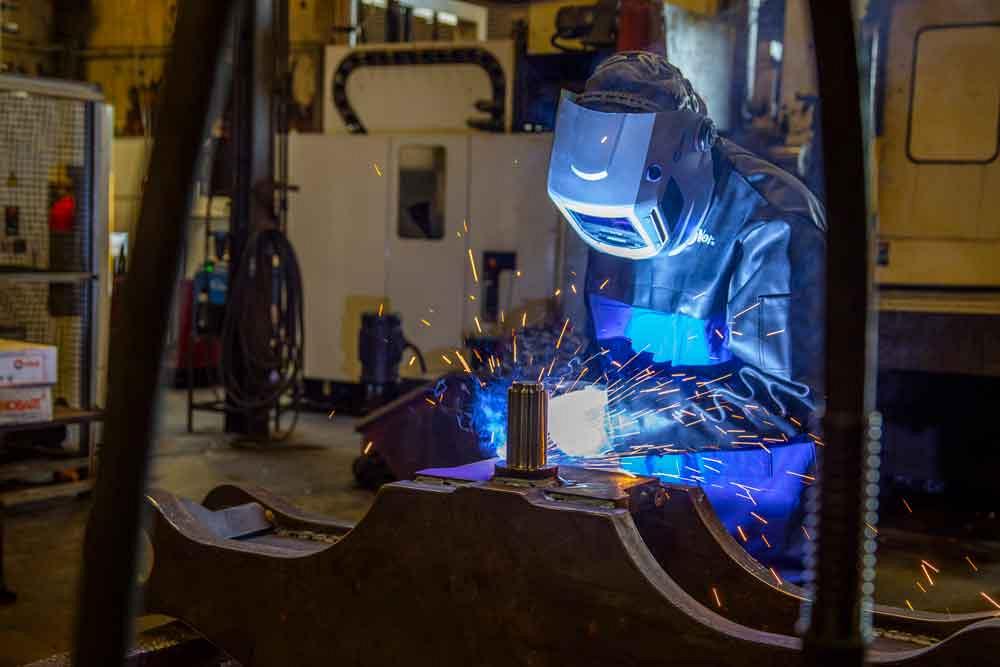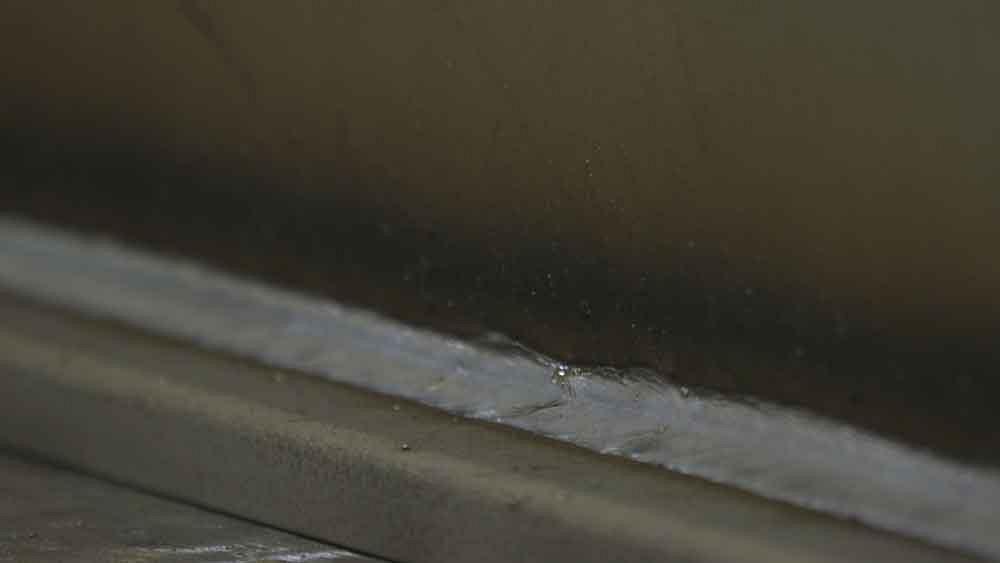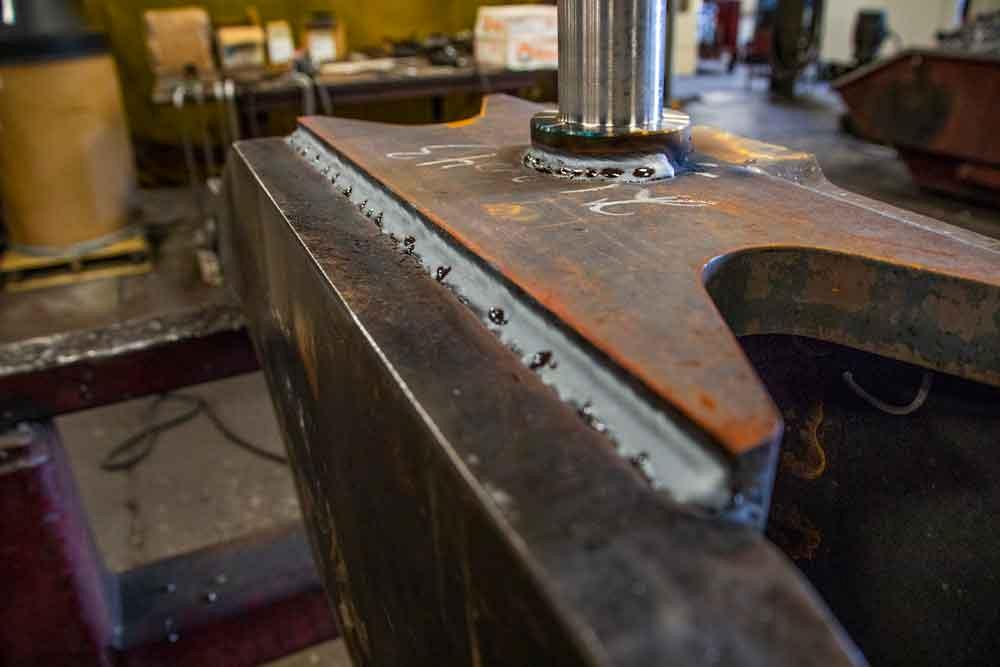Welding Engineer
- FMA
- The Fabricator
- FABTECH
- Canadian Metalworking
Categories
- Additive Manufacturing
- Aluminum Welding
- Arc Welding
- Assembly and Joining
- Automation and Robotics
- Bending and Forming
- Consumables
- Cutting and Weld Prep
- Electric Vehicles
- En Español
- Finishing
- Hydroforming
- Laser Cutting
- Laser Welding
- Machining
- Manufacturing Software
- Materials Handling
- Metals/Materials
- Oxyfuel Cutting
- Plasma Cutting
- Power Tools
- Punching and Other Holemaking
- Roll Forming
- Safety
- Sawing
- Shearing
- Shop Management
- Testing and Measuring
- Tube and Pipe Fabrication
- Tube and Pipe Production
- Waterjet Cutting
Industry Directory
Webcasts
Podcasts
FAB 40
Advertise
Subscribe
Account Login
Search
5 tips to increase welding throughput
Welding improvement requires a group effort, an open mind, and preparedness
- By Robert Fox
- July 15, 2020
- Article
- Arc Welding

Want to increase throughput in welding? Here are 5 tips to help keep an open mind and be more prepared.
Increasing throughput in welding isn’t a one-step process. It requires a commitment of time, labor, and financial resources to be fruitful. Undertaking such a project also requires an open mind. Assess whether a specific modification makes sense, and if it does, be prepared to make changes.
It might take more than turning a knob on a power source. For instance, switching filler metals may require requalification. You might need to make capital purchases, like fixturing or positioners, that take time to establish an understanding of the return on investment.
The goal is to create efficiencies throughout the operation, both upstream and downstream from welding, that increase the number of parts you send out the door. Consider the following five tips to help ease the process along the way.
1. Conduct a Time Study
A good first step, a time study can help identify the true source of bottlenecks. But to reveal them, you need to start the time study well before striking the first arc. Some processes are essential to prepare a part for welding, while others could be altered or eliminated. Those who hold certified welding inspector or certified welding supervisor certifications from the American Welding Society are typically well-versed in time-study protocols.
The study should identify and time every activity throughout the operation. Look at everything and record it. Account for part fabrication, bending or stamping, material handling into the weld cell, tacking and part fit-up, welding time, postweld cleanup, consumable and gas cylinder changeover, moving the parts out of the weld cell, painting, planned breaks, and unplanned breaks or downtime.
Once you finish the time study, put a plan in place that categorizes preweld, weld, and postweld activities. Pinpoint steps that don’t add value and hinder welders from completing welds as quickly as possible. For example, removing slag left by flux cored arc welding (FCAW) is a necessary evil, but it’s also a non-value-adding step that prevents you from completing welds as quickly as possible.
The plan should be accurate and actionable. The financial benefits of increased throughput cannot be realized if upstream processes do not feed parts to the weld cell consistently. Similarly, increased welding throughput has no effect if downstream processes can’t handle the increased volume and welded parts simply stack up as work-in-process. In these situations, avoid changes that leave welders standing idle, unless they can move and help achieve production goals elsewhere.
2. Create a Welding Procedure Specification
Welding procedure specifications (WPSs) help welders complete high-quality welds repeatedly. When followed properly, they help standardize the welding process.
An element of productivity factors into a WPS. The WPS communicates the required welding parameters that in turn help ensure welding takes place as efficiently as possible. Greater efficiency equals higher productivity and more parts produced.
A well-written WPS accommodates the realities and uncertainties of welding, like workforce skill and fit-up variation, but is restrictive enough to guarantee efficiency and quality. Having a WPS, good documentation for each weldment, and appropriate welder training helps ensure welds are completed quickly and correctly the first time. Consider developing a WPS for both flat/horizontal and out-of-position welding.

Made with metal-cored wire, this fillet weld has good fusion and wetting characteristics. Metal-cored wires offer a broad, cone-shaped arc that bridges gaps to combat the risk of burn-through and the lack of side-wall fusion.
Along with a WPS, a procedure qualification record (PQR) might be required by the fabrication code. Even in instances where a PQR is not required, it can be helpful. The PQR supports the WPS based on weld testing. It helps show that if welders follow the WPS, they will produce a sound weld with sufficient mechanical properties, minimizing the risk of rework that can reduce throughput dramatically.
3. Address Upstream and Preweld Processes
Part fit-up is a prime example of improving activities upstream. If a stamping die starts to wear, tolerances and fit-up can begin to vary. Poor fit-up forces you to modify welding parameters to prevent welding defects such as burn-through and undersized or missed welds, particularly in automated applications. For stamping operations, monitor the health of the dies and replace as necessary. For repeatable robotic welding, maintain part fixturing to ensure parts and welds are properly located.
Upstream processes can introduce contaminants such as machining or drawing oils that can contribute to porosity-related defects in welding. You can minimize these contaminants by modifying and implementing processes like preweld cleaning, which usually takes much less time than postweld rework.
Also consider the raw material’s condition. Welders need not clean off heavy rust and other contaminants if the material is clean to begin with. When possible, store raw materials in a clean, dry area. If this isn’t practical, consider alternative filler metals such as metal-cored or flux-cored wires that can weld through contaminants.
Certain preweld activities can benefit throughput in some applications but hinder it in others. Cambering, for example, helps compensate for distortion in large parts by introducing a bend or curve into a straight part. Subsequent welding distorts the bent part into its intended straightness. This helps minimize scrap and rework caused by distortion so more parts can go through the weld cell. However, the cambering operation costs time. If possible, reconsider the welding process or part design to reduce or eliminate the source of distortion itself.
4. Increase Arc-on Time
Optimizing welding parameters is one of the most important tasks to undertake in a weld cell, and it’s often overlooked.
Suboptimal welding parameters can keep welders or machinery from welding as fast as they could comfortably. Optimal parameters increase deposition rates, which can boost travel speeds and reduce the number of passes to complete a weld.
That said, consider the welding process you choose as well. Some have higher deposition rates than others, such as gas metal arc welding (GMAW) versus FCAW.
Also consider the filler metal you use. Some offer higher deposition rates and faster travel speeds within the same welding process—as is the case with metal-cored wires compared to solid wires. In addition to improving welding travel speed, metal-cored wires offer a broad, cone-shaped arc that bridges gaps to combat the risk of burn-through or part rework from a lack of side-wall fusion.
Also, take steps to prevent overwelding, which provides no practical improvement to weld performance at the expense of labor time and materials.
Whichever filler metal you use, consult the product data sheet prepared by the filler metal manufacturer. These offer valuable information that includes recommended amperages, volts, wire feed speed, and contact-tip-to-work distance. Confirm that welding travel and wire feed speeds are optimized and work well together to minimize overwelding and achieve an optimal bead contour.

Try selecting a wire that generates fewer silicon islands (shown here) so you spend less time removing them after welding.
5. Minimize Postweld and Downstream Activities
A root cause analysis can help identify ways to minimize postweld activities and keep parts moving. Unlike a time study that looks at every task in the welding operation and calculates how long it takes to complete them, a root cause analysis assesses why a problem occurs.
For instance, if parts with porosity reach the postweld area, what causes that porosity? It could be the weld settings, poorly or infrequently maintained nozzles, or shielding gas leaks. Identifying these root causes early reduces the need for fixes later in the operation.
Make sure welders are trained to identify and rectify welding discontinuities before a part leaves the weld cell. The time and cost of rework grow exponentially as the part progresses in the operation. By the time a defective part reaches the postweld area, it will require additional labor to fix it. Labor costs money. You also could incur expenses for replacement parts or additional operations.
vWhen possible, avoid producing ugly welds that require bead contouring (grinding/machining) to reduce stress risers and make them aesthetically pleasing. Instead, implement parameters in the weld cell that make the weld appearance better to begin with.Also consider using an antispatter compound or a low-spatter welding process and wire to eliminate the need for grinding off spatter. Select a wire that generates easy-to-remove slag, no slag, and/or fewer (or no) silicon islands; that way, you will spend less time removing them after welding.
Putting It All Together
Increasing welding throughput is a group effort. Everyone from top managers to front-line operators, including welders, should be invested in making improvements. Some cases may require additional welder training to learn new processes or to adjust to the nuances of a new filler metal. Regardless, keep the lines of communication open. An open exchange of ideas can go far in ensuring success.
About the Author
Robert Fox
101 Trade Square East
Troy, OH 45373
937-332-4000
subscribe now

The Fabricator is North America's leading magazine for the metal forming and fabricating industry. The magazine delivers the news, technical articles, and case histories that enable fabricators to do their jobs more efficiently. The Fabricator has served the industry since 1970.
start your free subscription- Stay connected from anywhere

Easily access valuable industry resources now with full access to the digital edition of The Fabricator.

Easily access valuable industry resources now with full access to the digital edition of The Welder.

Easily access valuable industry resources now with full access to the digital edition of The Tube and Pipe Journal.
- Podcasting
- Podcast:
- The Fabricator Podcast
- Published:
- 04/16/2024
- Running Time:
- 63:29
In this episode of The Fabricator Podcast, Caleb Chamberlain, co-founder and CEO of OSH Cut, discusses his company’s...
- Trending Articles
AI, machine learning, and the future of metal fabrication

Employee ownership: The best way to ensure engagement

Dynamic Metal blossoms with each passing year

Steel industry reacts to Nucor’s new weekly published HRC price

Metal fabrication management: A guide for new supervisors

- Industry Events
16th Annual Safety Conference
- April 30 - May 1, 2024
- Elgin,
Pipe and Tube Conference
- May 21 - 22, 2024
- Omaha, NE
World-Class Roll Forming Workshop
- June 5 - 6, 2024
- Louisville, KY
Advanced Laser Application Workshop
- June 25 - 27, 2024
- Novi, MI


























